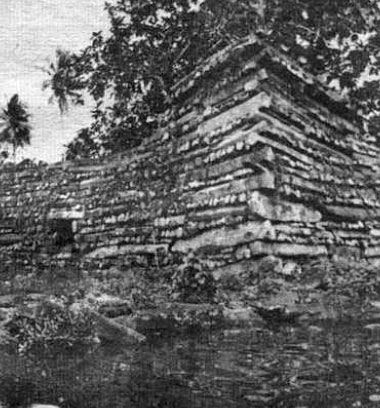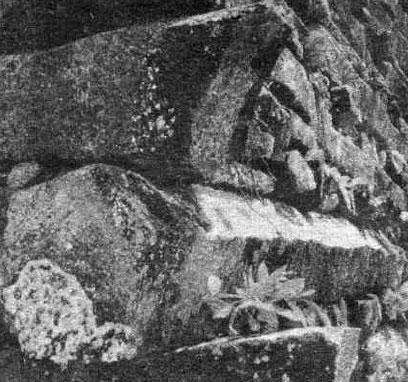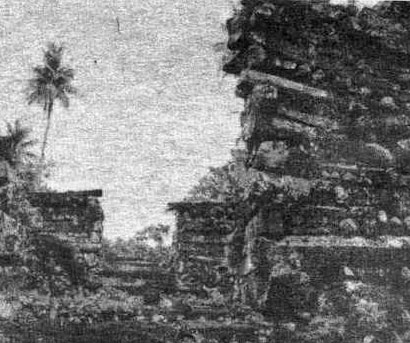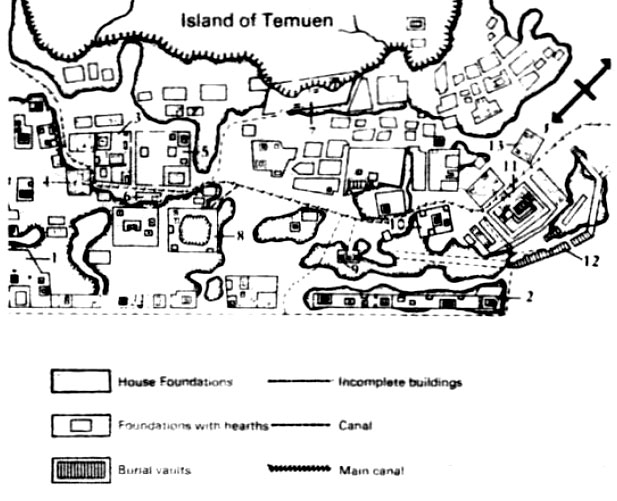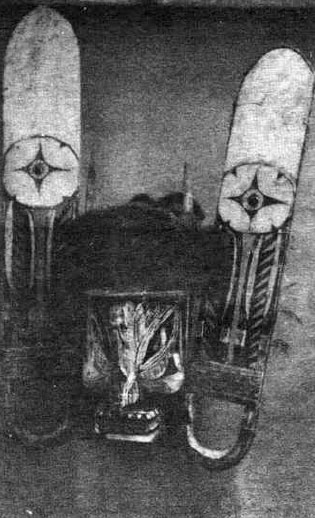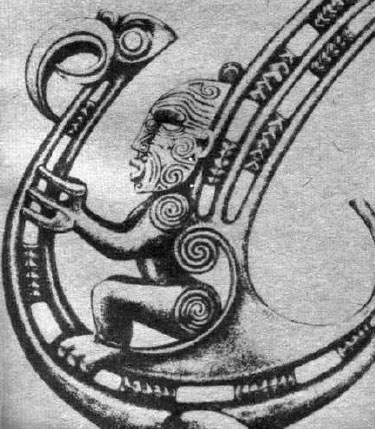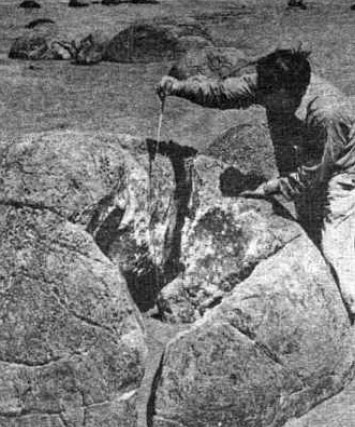|
Ponape is surrounded by a girdle of other islands, islets and coral reefs. One of the tiny islands, about as big as the Vatican City, is called Temuen, according to the atlas.
Temuen is the site of the mighty ruins of Nan Madol, which occupy nearly the whole of the island and account for its importance and fame, so that Temuen has long been known colloquially as Nan Madol. The ruins of Nan Madol go back to the remote past; but its prehistoric layout has not been dated and the origin of its builders is unknown.
Those are the undisputed historical data about Ponape. In other words, it is clear that the mysterious ruins on Nan Madol existed long, long before the first visit by white men in 1595.
It is not true that the history of the islanders only began to form part of the legend of Nan Madol after they themselves were discovered.
Their history since 1595 is more or less completely documented, but the legends about Nan Madol have far more to tell us than these recent facts, which implies that they are infinitely older. Are scholars trying to blind us with science simply because they cannot offer any convincing explanation of the mystery of Nan Madol?
With my two native guides, I passed several islets and then Nan Madol lay ahead of us, looking exactly the same as all the others, except for the strange burden it bore. This tropical island is the site of the small basalt city, the pantheon and legendary retreat of the prehistoric inhabitants, which is no bigger than a football stadium.
These evidences of prehistory confront one abruptly; there is no preparation for the "encounter."
Fig. 46. A corner of the city, slab piled upon slab, weighing tons.
The ground plan of the layout is clearly recognizable amid the confusion of the ruins, once you have had a good look round. Countless staves are piled on top of each other as in the game of spillikins.
It cannot have been an easy game, for the staves are basalt slabs or blocks weighing tons. (Fig. 46.)
Fig. 47. The basalt slabs, which are piled up to a height of 80 feet in some places, are hexagonal or octagonal and as much as 16 feet long.
More than 80 outbuildings, arranged on terraces, surround the main building.
The whole is enclosed by a protective wall 937 yards long and 16 feet high.
So far, so bad, for the blocks, which vary in length from 10 to 29 feet and often weigh more than 10 tons, must have been transported from the north coast of Ponape all the way through the labyrinth of jungle canals, past dozens of equally serviceable islands, to Nan Madol.
Transport by land is excluded, because since the remotest times downpours have flooded the dense jungle several times a day and in addition Ponape is mountainous. Even if we assume that roads were hacked out of the jungle and that there were means of transport that could surmount the mountains and force a way through the marshy morasses, the heavy loads would still only have reached the southeast corner of the island and would then have had to be loaded on to ships.
Yet the main building is only part of the layout. See map (Fig. 50).
There are canals, ditches, tunnels and an 875-yard-long wall, which measures 46 feet 6 inches at its highest point. The rectangular main precinct is arranged in terraces which are also built of perfect basalt squares. The main house that I measured has more than 80 outbuildings.
Using the figure of 32,000 as a basis, an estimate of about 4,000,000 basalt columns installed in the 80 minor buildings alone is probably on the low side. A trial calculation is often enough to show up false explanations. Like this one, for example.
Lastly a number of islanders must have been engaged in harvesting the coconut palms, fishing and looking after the daily supply of food.
Fig 49. This ground plan of the buildings at Nan Madol was made by Paul Hambruch during his field work in 1908-1910. It was brought up to date by K. Masao Hadley. The foundations are clearly visible among the ruins.
As there can have been no trade unions in those days, I assume that everybody worked and slaved 365 days a year. If 1,460 basalt blocks a year were landed on Nan Madol, it would have taken 296 years merely to get the material to the building site!
There are no reliefs, no sculptures, no statues or paintings. The architecture is cold and unfriendly. The basalt blocks are piled on top of each other harshly, crudely, threateningly.
The terraces that facilitate the climb up to the buildings reduce that supposition ad absurdum. No one ever made things so easy for their enemies In fact, the terraces lead to the center of the plan, to the "well."
This well is not a well, but the way down to the beginning or end of a tunnel. The fact that today the opening is full of water to barely six feet below the edge proves nothing, for the buildings of Nan Madol continue over the edge of the island and can be followed with the naked eye below sea level until they disappear in the depths
But what was a tunnel doing on a tiny island? Where did it-lead? I first read about this remarkable feature in Herbert Rittlinger's book The Measureless Ocean. Rittlinger, who traveled round the South Seas on a voyage of research, learnt on Ponape that the brilliant and splendid center of a celebrated kingdom had existed there untold millennia ago.
The reports of fabulous wealth had enticed pearl divers and Chinese merchants to investigate the seabed secretly and the divers had all risen from the depths with incredible tales. They had been able to walk on the bottom on well-preserved streets overgrown with mussels and coral. "Down below," there were countless stone vaults, pillars and monoliths. Carved stone tablets hung on the remains of clearly recognizable houses.
The Japanese divers reported that the dead were buried in watertight platinum coffins.
And the divers actually brought bits of platinum to the surface day after day!
In fact, the main exports of the island-copra, vanilla, sago and mother of pearl- were supplanted by platinum! Rittlinger says that the Japanese carried on exploiting this platinum until one day two divers did not surface, in spite of their modern equipment.
Then the war broke out and the Japanese had to withdraw.
All that happened about 1939 I do not believe in the metal or platinum coffins Hexagonal or octagonal basalt columns, overgrown with mussels and coral, could easily be mistaken for coffins under the water.
Never mind. The fact remains that Japan exported platinum from Ponape after its mandate in 1919. Where did all this platinum come from?
One point: Nan Madol has nothing in common with the legendary Atlantis that vanished into the sea in 9000 B.C., according to Plato. Here the buildings on dry land exist on the spot where they were laid out ages ago and their continuations under water were planned layouts which were constructed at the same time. There are relics of wonderful buildings here, but there is no miracle.
K. Masao Hadley, Pensile Lawrence and Carole Jencks, research workers living on Ponape, have collected material without attempting to interpret it.
The stories about the origin of the island and the buildings are woven round this formerly indigenous dragon. The dragon's mother had excavated the canals with her powerful muzzle and so created the islets.
The dragon had a magician as helper and this dragon-magician knew a rhyme with which, thanks to the power of the charm, he could make the basalt blocks fly over from the neighboring island, and then, with the help of another rhyme, use them to make buildings without the inhabitants of Nan Madol lifting a finger.
There are crocodiles in the South Seas about 3,000 miles from the island. A crocodile might have lost its way at some time- why not?-but that would still not be a reason for bringing a solitary saurian into the legend and leaving out the actual building of. the edifices at Nan Madol, which is far more impressive.
One crocodile left traces behind in the popular legend, but buildings whose elements are still astonishing and inexplicable today are left unmentioned. The crocodile obviously did not build terraces, houses and tunnels. Or did it? Naturally there are many more legends about Nan Madol than those of the dove and dragon.
In the second volume of his Results of the South Sea Expedition, 1908-1910 (Berlin, 1936), the German ethnologist Paul Hambruch gives a detailed survey of the sagas, myths and legends of the Caroline Islands.
The District Economic Development Office on Ponape sells tourists a brochure containing data about the history and legends for a dollar. If I have concentrated here on the dragon legend, I have a good reason for doing so. It is not because I have found a unique key witness for my theory of the gods.
The mass of additional legendary material is dominated by warlike events, lists of the descendants of ruling royal families, marriages and murders, as well as verifiable historical facts of more recent date. This extensive part of the legends is based on facts; it has a core of reality.
That seems only logical to me, for even the boldest imagination needs a spur, a launching pad, as it were, for daring ideas. Thus, when it is dealing with an apparent Utopia, the human imagination tends to use what it has experienced or at least what is conceivable at that time. Now dragons are a global element in myths and legends.
The earliest Chinese sagas mention them and they have their natural place in Mayan mythology.
These fire-breathing monsters are familiar to every ancient people in the South Sea community, though sometimes in the form of noisy, flying snakes. But they all possess the fabulous art of being able to carry very large and heavy objects over vast distances and setting them up in a prearranged order in a given place. What master builder of our own day would not like to be a dragon with such abilities?
They toiled with blood, sweat and tears for many generations. Why has not this tremendous achievement by the islanders been recorded and given prominence in established history if-as the archaeologists claim-it only took place 500 years ago?
The "proof of this recent dating is very flimsy. Six years ago some charcoal remains were found under a basalt block near the "well." Carbon 14 examinations gave a date around A.D. 1300.
The original inhabitants of all the Polynesian islands (total area 15,800 square miles) have common sagas and legends; they have common linguistic roots and with only a few variations they have a common appearance. They also have common gods!
The map of marine currents shows conclusively that the East Polynesian exporters must have reached New Zealand, the biggest island in the South Pacific, in their primitive canoes against the current.
A favorite explanation of this motorless and compassless traffic is that the seafarers between East Polynesia and New Zealand traveled so far in a northerly or southerly direction that they found themselves east or west of their goal-then the clever fellows slipped into the currents at exactly the right place.
What did they know about
the precise degree of latitude from which they had to turn off to
east or west? And how did they know their goal? Did they know that
other islands existed and where they were? Anyone who assumes that the ancient Polynesians made exact use of the currents-that ran counter to the directions of their expeditions-must be prepared to admit that knowledge of marine currents was familiar to them.
If scholars are ready to admit this necessary prerequisite for navigation between the islands, I will gladly support the current theory, but at the same time I must be allowed to ask the question whence they acquired this knowledge.
But if in spite of this, a raft or a canoe had landed by chance on the coast of a hitherto unknown island, the bold seafarers (against the current!) would never again have had any communication with their former home; they could not even have sent messages saying that they had landed.
If the foolhardy aquanauts had happened to put to sea again from the island they had landed on by chance, they would have got further and further away from their home port. Not even the strongest men could have managed the journey home in canoes.
Yet according to science they had another astounding achievement to their credit. They had no women with them, but they not only supplied the islands with culture, but also produced children who then multiplied vigorously. How did they manage that?
Kupe discovered the East Coast of New Zealand, went ashore and sent the two birds off to reconnoiter. One bird was given the task of measuring the marine currents and the drop in the rivers, the other had to analyze berries and plants to see if they were edible.
The first bird broke its wings while measuring a waterfall and being lame could no longer fly. The second bird, so the Maori saga goes, discovered such a delicious kind of berry that it decided to spend the rest of its life in the forest. Kupe never saw it again.
Consequently, it continues, King Kupe and his daughters could not return home.
The legend relates that Maaui hooked a fish that fought and bit and snapped so wildly that the god got into a rage and cut and hacked the fish to bits ... and that is why New Zealand is in pieces the way it is.
The Mahia peninsula, Te Matau a Maaui, is the fishhook, the Wellington region, Te Upoko O Te Ika, the head, and the North Auckland peninsula, Te Hiku O Te Ika, the fish's tail. That is a story that bears thinking about. When the god Maaui caught land, there were no maps in existence. But one look at the atlas confirms how accurately this legend outlines the shapes of New Zealand.
You
can see the ray-like fish with its open mouth in the south, and the
long tail in the north with one fin on the hook.
With a touch of our magic wand let us turn the god Maaui into that valiant aviator Charles Lindbergh who flew the 3,750 miles from New York to Paris in 33 hours on May 20 and 21, 1927.
Alone in the wind lashed, one-engined machine, all he could see below him was water, water, water. One and a half days all alone high above the water-a nightmare! Way down below Lindbergh saw a dark spot. A big fish? An island? A shoal of fish? An archipelago?
Lindberg slowly reduced altitude until he recognized that the dark spot in the Atlantic consisted of islands. The lone aviator's tension relaxed; he had "fished" a bit of land. Very funny, I shall be told, because the Polynesians in the remote past had not mastered the art of flying.
The objects cataloged as masks (Fig. 50) will easily be recognized as poor copies of one-man flying machines by anyone who does not obstinately claim in the face of all prehistoric evidence that they are "religious masks," "ritual garments" or "ritual requisites" (whichever suits the anthropologists best) and who is also prepared to interpret the finds on Polynesian islands (and elsewhere) from the modern point of view.
The "masks" were pulled over the head from above; the movable flat wooden side pieces were nothing more or less than wings. One can see the holes for fitting the arms through at the other end. Even the arm and leg supports, yes, the whole "corset" into which the aviator had to squeeze himself, have remained a memory to Polynesian folk artists for millennia.
Obviously they no longer know why they decorate and equip their gods and kings with such complicated apparatuses.
No one has been able to fly with this gear for many, many thousands of years. But in the remote times when Maaui "fished" the islands, certain specialists among the population could fly with these machines!
These admittedly poor copies of very early flying machines have been promptly and without exception declared "ritual attributes" on all sites and in all museums. The four-winged beings in Assyria were ritual beings. Pottery artifacts with technical drawings of circular and spherical ornaments were ritual objects.
Americans and Russians use these one-man flying machines, originally constructed for space travel, to take individual commandos to their destination over hills and rivers. Even one-man helicopters are no longer a Utopian idea. Rotor blades are mounted on a motor carried on the back, on the chest is a small box with the controls.
If a child was given some wood and straw and asked to knock up a strange aviator like those that he had seen on television, a "ritual mask" would certainly result.
But the child would consider it as "his" flyer.
Now it would clearly be exceeding the ration of audacity I have allowed myself if I were to claim that the earliest ancestors of the Polynesians had teachers from an alien technologically advanced civilization from the cosmos ... if the South Seas peoples' legends did not do precisely that.
In his Ancient History of the Maori, New Zealand, 1889, John White has assembled South Sea legends with the scrupulous care of a scholar. When he began his work in 1880, he was told many prehistoric stories at first hand by the priests.
The subjects in the first volume alone show where the origin of prehistory is to be sought:
The Rongamai legend is about tribal warfare. Afraid of being overcome, the Nga-Ti-Hau tribe sought safety in a fortified village. When they were threatened by an invincible opponent even there, the Nga- Ti-Hau warriors sought the help of the god Rongamai.
When the sun was at its zenith, the god appeared:
Rongamai flew over the village square and landed:
The warriors were given fresh courage by this display of strength by the god and overran their astounded enemies.
Then, no longer a maiden, she brings a daughter into the world and after giving birth returns into the cosmos.
But whatever the variant an old woman is always present at take-off. Crouching on the ground, she counts potatoes.
She warns the deities of "winds that blow earthwards" and then she throws the potatoes into the fire, one after another, nine, eight, seven, six, five ... The old woman organized a regular countdown, just like they do at a Space Center.
In Polynesian Mythology, Wellington, New Zealand (undated), there is a legend which the Polynesian fishermen used to tell:
It is remarkable that the simple Polynesian fishermen should mention a cold, empty, lofty space "up there" in their legend. They knew a lot about land and sea, but how did they know about the lofty space up there?
Fig 50 The Bishop Museum at Honolulu, Hawaii, contains many such copies of flying machines, cataloged as "ritual masks" by scholars. But it would take less imagination to identify these "memories," which have been made for many centuries, as aids to flying that were pulled over the head, with the flat pieces of wood as wings, with supports for arms and legs and the corset into which the flyer had to squeeze himself.
Rupe girded and masked himself and climbed up to the heaven.
Rupe struggled up to the second heaven and again found men, whom he also asked:
Yet again Rupe struggled upwards and again he found a place that was inhabited.
Rupe did not give up, laboriously and with his last remaining strength he reached the tenth heaven where he found Rehua (also known as Hinaura).
One legend recounts that he created the first woman and another that after the second great war in the heavens Tane forced the rebel gods to descend to other worlds in the darkness to live there in despair for eternity. But Tane supplied the losers of the cosmic battle with all his knowledge and skills for their flight into damnation.
I should also like to remind readers of the main work of the Cabbala, the Book Zohar, which contains Rabbi Simon Bar Jochai's report of a conversation between an earth-dweller and a being stranded from the world of Arqua.
Refugees, who had survived a terrestrial catastrophe, were walking along led by Rabbi Yosse when they met a stranger who suddenly emerged from a crack in the rock. Yosse asked the stranger where he came from.
He answered:
The surprised Rabbi asked:
The stranger replied:
And he said that in "his" world the seasons were different from those in "their" land, that there seed and harvest would only renew themselves after several years and that the inhabitants of Arqua visited all worlds and spoke all languages.
Fig. 51. The contemporary counterpart to the South Sea Islanders' flying machine: rocket belts as used by Americans and Russians for one-man commandos. Yet archaeologists would say that when our children make imitation rocket belts of wood and straw they are making ritual masks!
These direct and unequivocal references to other worlds (other planets) are there in the legends.
I cannot change them. They are always interpreted with the old exegeses that have led nowhere. Yes, say the exegetes, such legends cannot be explained unless one adopts the way of thinking of our remote ancestors.
But do they do that? They think they have In reality the conceptual world of prehistoric peoples, some of whom have vanished without trace, simply cannot be recreated in retrospect, we can only guess that they must have thought in such and such a way. It is only an assumption. Every interpretation is ensnared and caught in the way of thinking of the age in which it is made, but even then with limitations.
The legends were wishful thinking on the part of the unconscious. They even enroll my fellow-countryman Carl Gustav Jung (1875-1961) with his doctrine of psychic energy, his theory of individuation, and especially his theory of the archetype with primordial innate ways of behavior and images.
The world is in order again.
Innate ways of behavior? Primordial images?
I have nothing against the wish to be able to fly, I like flying very much myself.
In the Babylonian Epic Etana is obsessed with the wish to fly.
He may have dreamt about it, he may have talked about it, but neither dreams nor imagination can have given him such a picturesque description of the earth's surface as the one in the epic:
And wishful thinking could not possibly have supplied Enkidu with the description of the earth- as seen from above-in the Epic of Gilgamesh.
In Volume 18 of the yearbook of the Society of German Engineers, Berlin, 1928, Professor Richard Henning examines texts relevant to the prehistory of air travel.
He describes the Etana legend as definitely the "oldest flying saga in the world," and one which must go back to the very beginning of history, because it is already represented pictorially on a cylinder seal from the period between 3000 and 2400 B.C., whereas the text has been only partially preserved in a cuneiform inscription.
This passage struck the professor as especially noteworthy :
Accurate descriptions, pictorial representations as products of the unconscious?
Here I think the psychoanalysts should curb the adepts of their science if they themselves want to remain credible. Our research into myths and legends and the interpretations of archaeology are-as far as they concern prehistory-tied up in a straitjacket of preconceived views. Eyes have grown blind, ideas become dead.
Science says that it cannot accept imaginative solutions because they have no empirical or demonstrable foundation. But now serious conclusions become more and more fantastic every day, while at the same time the disparaged fantasies acquire a firmer background. Three premises are the basis of all research: freedom of thought, a gift for observation and a sense of connections. Laymen can make use of them too.
The oldest Maori prayer is attributed to this Pourangahua:
Fig. 52. According to the Maori legend, the god Pourangahua flew on his magic bird from his legendary dwelling Hawaiki to New Zealand.
"I come and a new
heaven turns above me ..."
These balls lie here in Moeraki Bay as if they had risen from the sea. Unlike the similar phenomenon in Costa Rica, these balls originated from natural causes - 135,000,000 years ago during the Upper Cretaceous.
On Moeraki Beach, north of Dunedin, dozens of them of all sizes are strewn about (Fig. 53). Having become interested in balls after seeing the artificial stone balls of Costa Rica, I naturally examined the New Zealand variety very closely. These balls originated from natural causes.
They form in soft sandstone by deposits of calcspar around a core. Geologists date the beginning of the formation of the balls to the Upper Cretaceous, 135,000,000 years ago.
Although they are of natural origin, there are some strange varieties among them, the so-called geodes. A geode is a word used in geology that comes from the Greek. It consists of a stone in which a hollow space has been caused by gas, the space being wholly or partially filled with minerals or crystalline deposits.
Geodes are not only eagerly sought after by geologists, but also by business-like laymen who turn them into desirable trinkets for sale in gift shops by cutting, halving, quartering and polishing them. Treasure seekers of this kind found a stone that looked like a geode in 1961 near Olancha, on the edge of the Amargosa Desert.
So they put it in their collecting basket, the contents of which they prepared for sale on their return.
When they tried to saw through the putative geode, the diamond saw broke, because the stone was not hollow, but solid, in spite of its appearance. Geologists who dissected the stone found inside it an unknown stone with an iridescent surface that had been formed under the effect of intense heat.
In its core was a shining metal rod 2 millimeters in diameter and 17 millimeters long.
Strange?
The American Trust Administration is doing its best to improve the infrastructure of the island.
Roads are being built on Ponape; an electricity works is already functioning; the harbor is being enlarged, a radio station floods the island and its islets with music. But this is all in its early stages, which makes it all the more surprising that nearly every native family on the impoverished island is the proud possessor of a car!
In many huts, even those without electricity, there are juke-boxes.
The owner of my so-called first-class hotel had three of them and they were always nerve-rackingly in use. The few guests could pass the time playing the two pin-tables and on the day I left the island an electric adding machine was delivered to his establishment.
Where do the islanders get all the money for so many useless things?
I kept on remembering the Japanese divers who had brought pieces of platinum up from the ocean bed. Perhaps I missed a chance to get to the bottom of all secrets in one moment of complete clairvoyance. On the day before my departure, I was invited by some natives to their village.
I had known for a long time that such gestures of hospitality ought not to be rejected. You can never return to the village which has invited you, if you have been impolite.
The oldest woman of the tribe greeted me and led me through some huts to the village square. Women and girls crouched in front of a hollow tree trunk and when they caught sight of me began to beat out a rhythm with sticks that had a kind of blues tempo. Men and boys entered the circle and began to stamp their feet, and as they gyrated they beat very skillfully on some more tree trunks that gave out a different note.
They drew me into their ring, which was quite calm to begin with, but hotted up terribly as the ladies' rhythm group set a fearful tempo. The air was hot and sticky and I had to join in, jumping up and down, running and stamping in the circle-the only thing I was spared was the wooden spear. The rock'n'roll of the fifties was like a tango compared to our performance.
The roots were superficially cleaned with bunches of lianas and laid on the stone. The men took stone pounders and hammered the roots in unison for about half an hour. The roots turned into a sticky brown porridge-like mass.
The teenagers brought vegetable fibers and spread them carefully on the edge of the stone.
Then the men who had been pounding the roots spread the mixture on the fibers, which were then tied to a rope. The evil sauce that dripped into coconut shells was sakao. An innocent youth - the rites prescribe that it must be an innocent youth - knelt before me and proffered me the shell, without looking me in the eyes (which is strictly forbidden). The things one does in the name of international understanding!
I raised the shell to my lips; all eyes were on me and I forced down a couple of mouthfuls. I handed the shell to my neighbor who swallowed the fearful brew as if it were vintage champagne.
The shell was refilled and everyone enjoyed the festive drinking bout until they soon lay down and fell into a deep blissful sleep. (*)
(*) The same drink is called yangona in the Fiji Islands and kava on Tonga and Samoa.
Connoisseurs told me that sakao is supposed to have an effect like LSD. I have read that LSD produces moments of unprecedented, incredible clairvoyance.
If I had swallowed more of the vile juice, I might possibly have been granted that illumination which would have explained the secrets of Nan Madol in a flash. So I shall have to hand on my questions to the experts, who so far have been seeing "in a glass darkly," with singular lack of clairvoyance.
|
